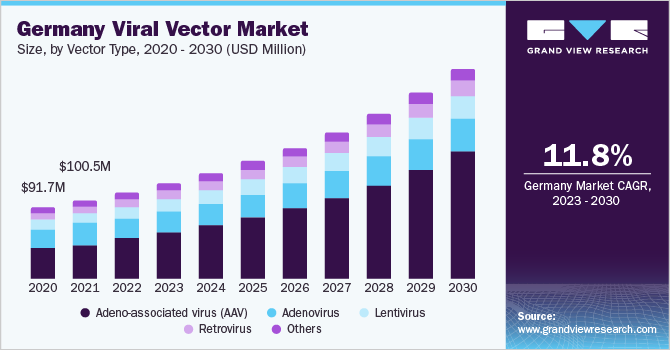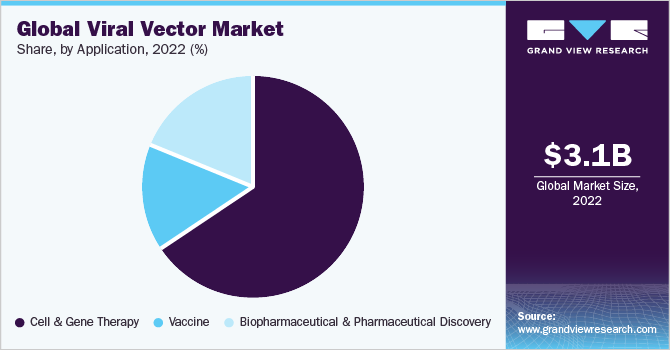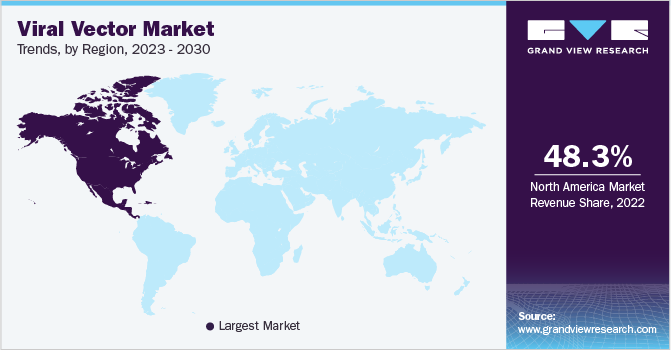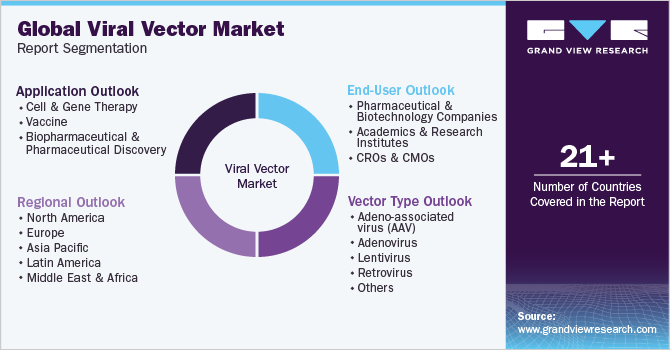- Home
- »
- Biotechnology
- »
-
Viral Vector Market Size, Share & Analysis Report, 2030GVR Report cover
![Viral Vector Market Size, Share & Trends Report]()
Viral Vector Market (2023 - 2030) Size, Share & Trends Analysis Report By Vector Type (Adeno-associated Virus (AAV), Adenovirus, Lentivirus, Retrovirus, Others), By Application, By End-user, By Region, And Segment Forecasts
- Report ID: GVR-4-68040-072-3
- Number of Report Pages: 120
- Format: PDF
- Historical Range: 2018 - 2021
- Forecast Period: 2023 - 2030
- Industry: Healthcare
- Report Summary
- Table of Contents
- Interactive Charts
- Methodology
- Download FREE Sample
-
Download Sample Report
Viral Vector Market Summary
The global viral vector market size was estimated at USD 3.10 billion in 2022 and is projected to reach USD 7.35 billion by 2030, growing at a CAGR of 11.5% from 2023 to 2030. The increasing prevalence of target diseases and genetic disorders along with technological advancements in digital diagnostics is expected to support the market growth for viral vectors.
Key Market Trends & Insights
- North America dominated the global market with the largest revenue share of 48.31% in 2022.
- By application, the cell and gene therapy segment led the market with the largest revenue share of 65.4% in 2022.
- By end user, the pharmaceutical and biotechnology companies segment led the market with the largest revenue share of 53.1% in 2022.
- By vector type, the adeno-associated virus (AAV) segment dominated the global market by generating revenue of USD 1.47 billion in 2022.
Market Size & Forecast
- 2022 Market Size: USD 3.10 Billion
- 2030 Projected Market Size: USD 7.35 Billion
- CAGR (2023-2030): 11.5%
- North America: Largest Market in 2022
Furthermore, increasing the effectiveness of viral vectors in gene therapy delivery is contributing to market growth. The COVID-19 pandemic curated a positive impact on the global market. Owing to the high mortality rate of the COVID-19 virus, pharmaceutical, and biotechnology companies were rushed to start the research and simultaneous manufacturing of Sars-Cov-2 specific vaccines. Viral vector technology has been an established and trustable source for vaccine development. For instance, Oxford-AstraZeneca COVID-19 vaccine was made from the adenovirus vector from the already made MERS vaccine, which was clinically tested before. Thereby, the familiarity with the adenoviral properties of the vaccine allowed for a faster commercialization process, allowing billions of people to benefit from it. As per AstraZeneca, in November 2021 , nearly two billion doses of the vaccine were supplied to 185 countries, marking it as the highest geographical coverage COVID-19 vaccine. However, the pandemic also disrupted supply chains of critical raw materials which led to manufacturing challenges of viral vector therapies and other biologics. Additionally, the clinical trials were delayed which curated a longer commercialization time for various drugs and therapies dependent on viral vectors.
The rising prevalence of genetic disorders and contagious diseases is anticipated to boost the demand for viral vectors. For instance, according to the Joint United Nations Programme on HIV/AIDS (UNAIDS) data, around 38.4 million people had HIV in 2021, and at the end of 2021, 28.7 million people had accessed antiretroviral treatment. This is fueling market growth. Furthermore, government initiatives such as direct growing demand for innovative clinical therapies, funding for viral vector manufacturing, and an increasing focus on the emerging area of medicine for genetic disorders, which has helped by transforming techniques, are driving market expansion.
Increasing awareness about gene therapy coupled with the advancements in genome sequencing and a greater understanding of DNA sequences among populations for research are important factors fueling the market. The use of viral vectors in gene therapy has become a highly prospective and fast-emerging technology in recent years. Despite the difficulties previously, the widespread acceptance of viral vector therapies-many of which are in advanced stages of clinical trials-has significantly increased the amount of research in this area of gene therapy. Important vectors currently being researched and employed in clinical trials are retroviral, adenoviral, adeno-associated viral, and lentiviral based. For example, as per National Center for Biotechnology Information 2022, 137 adeno-associated viral based therapy was in clinical stages. Moreover, predominant clinical trials were in the early stages, however, around 7.7% have reached phase III.
Vector Type Insights
In 2022, adeno-associated virus (AAV) segment dominated the global market by generating USD 1.47 billion in revenues and is estimated to grow at a CAGR of 14.80% from 2023-2030. AAV vectors provide a high degree of safety and efficacy, while also allowing to target specific cell types in the body. Gene therapy via adeno-associated virus offers a permanent correction of genetic diseases such as spinal muscular atrophy (SMA). For instance, in 2019, Zolgensma became the first approved AAV vector-based gene therapy to treat SMA in infants and offered a distinctive advantage of being administered in single infusion, then other drug classes which need multiple infusions. Additionally, AAV vectors are highly stable when compared to other forms of viral vectors and manufacturers can produce them in large quantities for heavy-scale manufacturing, thereby, allowing for market expansion.
Lentivirus segment is expected to grow at a CAGR of 8.1% over the forecast period. Lentiviral vector offers a larger capacity for genetic material than other forms of vectors, allowing them to carry larger genes or multiple genes at once. Additionally, lentivirus can infect both dividing and non-dividing cells, allowing them to be used as a therapeutic gene for different cell types in the human body. Additionally, FDA has recognized lentiviral based therapy owing to its capability to provide patients an alternative to pre-existing medications highly prone to complication. For example, in September 2022, the U.S. FDA granted approval at an accelerated pace for SKYSONA- a lentiviral vector gene therapy shown to slow the progression of neurodegenerative dysfunction, or active cerebral adrenoleukodystrophy in boys with the age range of 4-17. Lastly, another form of lentiviral vector gene therapy known as ZYNTEGLO was approved by the FDA in August 2022 to offer a one-time treatment for beta-thalassemia.
Application Insights
Cell and gene therapy segment held the highest share of 65.4% in 2022 and is estimated to grow at a CAGR of 12.7% over the forecast period. Cell and gene therapy utilizes viral vectors to deliver therapeutic genes to the patient cells, primarily suffering from genetic disorders. Additionally, an increase in the number of clinical trials and overall regulatory approval has allowed for fast-paced growth in the therapeutic segment. For instance, by October 2021, eight therapies were approved by the U.S. FDA working on viral vectors. Additionally, an extensive clinical trial pipeline extrapolates the growth of viral vectors in cell and gene therapy. For example, as per NCBI March 2021, 284 active clinical trials were being conducted for viral vector-based gene therapies. The following factors provide the segment with market expansionary force.

Biopharmaceutical & Pharmaceutical Discovery segment is expected to grow at a CAGR of 9.8% over the forecast period of 2023-2030. Researchers utilize viral vectors as a tool to deliver genes into cells to understand their function, which in turn helps in the understanding of disease mechanisms and potential targets for drug development. For example, researchers can use viral vectors to create knockout or knock-in models of genes to study their function and investigate their potential as therapeutic targets. In addition, viral vectors can be used to deliver RNAi or CRISPR/Cas9 gene editing tools to investigate gene function and validate drug targets. For instance, as per Nature’s Article published on February 2023, adenoviral structural proteins are manipulatable, allowing it to be advantageous in tissue-specific tropism. Thereby, the adenoviral vector becomes indispensable for CRISPR and Cas delivery.
End-user Insights
Pharmaceutical and biotechnology companies segment held the highest share of 53.1% in 2022. The dominant share is due to the extensive usage of viral vectors by these end-users for drug discovery and development, gene therapy manufacturing, vaccines, and other forms of biologics. The following firms have larger access to generate funds from various public and private sources for different social causes. For example, Oxford-AstraZeneca’s COVID-19 vaccine was developed using Ad26 as the viral vector and had the encodement of the Sars-CoV-2 spike protein. Additionally, the firm had a strong base for funding which extrapolated the process. For instance, as per Guardian 2021, Oxford COVID-19 vaccine received at least 97% of the research & development funds from public or government sources. It is due to the following reasons, the segment holds a dominant share.
CROs and CMOs segment are anticipated to register a CAGR of 10.7% due to 2023-2030. CROs and CMOs allow faster turnaround times and overall flexibility in the development and manufacturing of viral vector. Additionally, viral vectors can be provided on demand by such companies which acts as an essentiality for larger healthcare firms looking to accelerate the drug development timelines. Lastly, various strategic moves are being made by contract manufacturing firms to assist in the expansion of viral vectors. For instance, in 2021, AGC Biologics added the vector suspension technology along with the increased capacity for the development of gene therapies in Colorado. Critically, the site expansion doubles the viral vector capacity, which will aid to supplement the growing demand for viral vectors.
Regional Insights
North America dominated the global market with a share of 48.31% in 2022. North America leads the market due to a strong biopharmaceutical industry, with leading pharma and biotech companies operating in the region. Additionally, the following firms engage in the development and commercialization of gene therapies and other biologics which propels the viral vector usage. Moreover, North America’s ease of funding has had a positive impact on the viral vector industry, as various venture capitalist, government sponsored programs, and other investors propel the market forward. For instance, funding of USD 2 billion was sanctioned by the White House in September 2022 to supplement the biotechnology and biomanufacturing space. The following move provides fiscal strength for viral vector industry growth.

The Asia Pacific is anticipated to expand at a maximum growth over the forecast period with a CAGR of 13%. It is owing to a massive increase in the manufacturing footprint to support viral vectors in gene therapies and vaccines. For example, as per Bioprocess International Article in April 2023, India, and China together account for 16.4% of the global biomanufacturing capacity. Additionally, as per India Bioeconomy Report March 2021, China accounts for dozens of cells and gene therapy developers which stands only second to the U.S. Thus, the following attributes would allow for extensive growth of the viral vector market in Asia-Pacific.
Key Companies & Market Share Insights
The high demand for viral vector for multiple applications has led to numerous market opportunities for major players to capitalize on. Key players are involved in strategic initiatives such as mergers, acquisitions, and collaborations to maximize their market share. For instance, in January 2023, Forecyte Bio, a CDMO dealing with cell and gene therapies opened a new GMP facility to facilitate the manufacturing of viral vectors, cell therapies, and others. Additionally, the facility will have around 17,000 square feet of space and contain specific cleanrooms for each purpose. Some of the key players in the global viral vector market include:
-
Oxford Biomedica
-
Lonza
-
Thermo Fisher Scientific Inc
-
Batavia Biosciences B.V.
-
Biogen
-
Spark Therapeutics, Inc.
-
Regenxbio Inc.
-
uniQURE N.V.
-
Asklepios BioPharmaceutical, Inc. (AskBio)
-
Sanofi
Viral Vector Market Report Scope
Report Attribute
Details
Market size value in 2023
USD 3.43 billion
Revenue forecast in 2030
USD 7.35 billion
Growth rate
CAGR of 11.5% from 2023 to 2030
Base year for estimation
2022
Historical data
2018 - 2021
Forecast period
2023 - 2030
Quantitative units
Revenue in USD million/billion, and CAGR from 2023 to 2030
Report coverage
Revenue forecast, company ranking, competitive landscape, growth factors, and trends
Segments covered
Vector type, application, end-user, region
Regional scope
North America; Europe; Asia Pacific; Latin America; MEA
Country scope
U.S.; Canada; Germany; UK; France; Italy; Spain; Denmark; Sweden; Norway; China; Japan; India; South Korea; Australia; Thailand; Brazil; Mexico, Argentina; South Africa; Saudi Arabia, UAE; Kuwait
Key companies profiled
Oxford Biomedica; Lonza; Thermo Fisher Scientific Inc; Batavia Biosciences B.V.; Biogen; Asklepios BioPharmaceuticals, Inc.; Sanofi; Spark Therapeutics; Regenxbio Inc; uniQURE N.V.
Customization scope
Free report customization (equivalent up to 8 analyst’s working days) with purchase. Addition or alteration to country, regional & segment scope.
Pricing and purchase options
Avail customized options to meet your exact research needs. Explore purchase options
Global Viral Vector Market Report Segmentation
This report forecasts revenue growth and provides an analysis of the latest trends in each of the sub-segments from 2018 to 2030. For this report, Grand View Research has segmented the global viral vector market report based on vector type, application, end-user, and region.

-
Vector Type Outlook (Revenue, USD Million, 2018 - 2030)
-
Adeno-associated Virus (AAV)
-
Adenovirus
-
Lentivirus
-
Retrovirus
-
Others
-
-
Application Outlook (Revenue, USD Million, 2018 - 2030)
-
Cell & Gene Therapy
-
Vaccine
-
Biopharmaceutical & Pharmaceutical Discovery
-
-
End-User Outlook (Revenue, USD Million, 2018 - 2030)
-
Pharmaceutical & Biotechnology Companies
-
Academics & Research Institutes
-
CROs & CMOs
-
-
Regional Outlook (Revenue, USD Million, 2018 - 2030)
-
North America
-
U.S.
-
Canada
-
-
Europe
-
UK
-
Germany
-
France
-
Italy
-
Spain
-
Denmark
-
Sweden
-
Norway
-
-
Asia Pacific
-
Japan
-
China
-
India
-
South Korea
-
Australia
-
Thailand
-
-
Latin America
-
Brazil
-
Mexico
-
Argentina
-
-
Middle East & Africa
-
South Africa
-
Saudi Arabia
-
UAE
-
Kuwait
-
-
Frequently Asked Questions About This Report
b. The global viral vector market size was estimated at USD 3.10 billion in 2022 and is expected to reach USD 3.43 billion in 2023.
b. The global viral vector market is expected to grow at a compound annual growth rate of 11.5% from 2023 to 2030 to reach USD 7.35 billion by 2030.
b. North America dominated the viral vector market with a share of 48.31% in 2022. This is attributable to the increasing number of vaccine manufacturing locations and the high number of approved gene therapies
b. Some key players operating in the viral vector market include Oxford Biomedica; Lonza; Thermo Fisher Scientific Inc.; Cell and Gene Therapy Catapult; Genezen Laboratories; Sarepta Therapeutics; Spark Therapeutics; Genprex
b. Key factors that are driving the viral vector market growth include an increasing number of pipeline gene therapy candidates along with rising demand for viral vectors from vaccine manufacturers
Share this report with your colleague or friend.
Need a Tailored Report?
Customize this report to your needs — add regions, segments, or data points, with 20% free customization.

ISO 9001:2015 & 27001:2022 Certified
We are GDPR and CCPA compliant! Your transaction & personal information is safe and secure. For more details, please read our privacy policy.
Trusted market insights - try a free sample
See how our reports are structured and why industry leaders rely on Grand View Research. Get a free sample or ask us to tailor this report to your needs.










